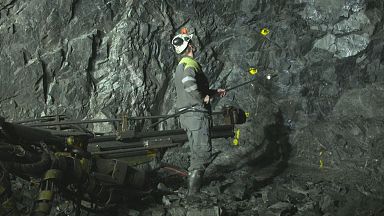A European research project in Kista in Sweden is working on a new instrument. The X-Mine European project hopes to reduce costs and time by using scanners and 3D technology.
Mining exploration takes a long time and the procedures are expensive. In order to understand the composition of a rock it takes several weeks. By combining X-ray based technologies and 3D modelling technology, there's now a solution that could revolutionize the length of time and cost of mineral analysis.
The products from mining are around us almost in every single aspect of our lives. Searching for these materials, which are hidden in the rock hundreds of metres underground, is similar to a treasure hunt. Around one in every thousand mine exploration provides a positive result.
X-Mine European research project
A European research project in Kista in Sweden is working on a new instrument. The X-Mine European project at Orexplore Lab hopes to reduce costs and time.
Stefan Sadbom a Geologist, Bergskraft Bergslagen AB said, "For the geologist the eye is, of course, the most important tool here, but, then, there are properties that my eyes cannot see, and this is also something fantastic with this technology: I can see inside the rock, and I can see what I cannot see with a naked eye."
How the X-Mine European project works
To evaluate the potential of a mine and where to locate positions for excavations, a lot of drill cores have been analyzed by specialized laboratories. This takes several weeks. The "mineral detector" can reveal the composition of rock samples in a few minutes, directly at the mining site. There's no need to send it away to another country for testing.
Mikael Bergqvist, Research and Development Manager, Orexplore said, "We are applying some medical technologies to these drill cores. We are using CT scan, a computerized tomography scanner, combined with other X-ray information to get the most information we can, out of these drill cores."
What happens next
Geologists can then 'read' the minerals in an unprecedented manner and understand where to locate the next excavations.
"All mines have a unique characteristic in terms of the geochemical signature of the rocks. Making a 3D modelling of a mining site is actually comparable with a building upside down, like the empire state building underground, and you want to map out every single room in that building in terms of metals, structures, how they are organised...that is exactly what X-Mine focuses on," said Stefan Luth, Geologist, Geological Survey of Sweden.
Sustainable mining
The real-time analysis of rock samples reduces the need for extended explorations and blasting; this means nearly one quarter less of energy consumption is used and there are less CO2 emissions.
"We need sustainable mining, we need lower energy consumption, less waste and less CO2 emission. Here we are developing the technology to reach those goals for this for sustainable mining," said Janne Paaso, X-Mine Project Coordinator Research Scientist, VTT Technical Research Centre of Finland.
Mineral sorting plant in Poland
The integration of this technology in a mineral sorting plant enables a real-time selection of the material from the mine. Optical and X-ray sensors above the belt can analyze the rocks while they're moving and select the ones rich in precious material. This machine, which is being tested in Poland, is able to process dozen of tons of material per hour.
Jacek Kolacz, CEO, Comex Group said, "The computer system is providing the information for the pneumatic valves, which particle has to be rejected at which time. The physical separation is done by pneumatic valves, these valves are placed in that area at the end of the discharge of the belt, where the particles are falling in the free fall from the belt. Those we want to reject are rejected by small short pneumatic pulses and they are falling on a different belt."
The future in Europe
The drill core analyser will be upgraded to detect more precious minerals such as gold in 2020 and the sorter machine will be on the market by 2021.
The EU relies on importing a huge amount of its mineral and metal needs. It receives the majority of critical raw material from China, taking 62% of China's 70% global supply.
In 1850 Europe's share of global production was 50% but in 2009 this figure decreased considerably to just 5%.












